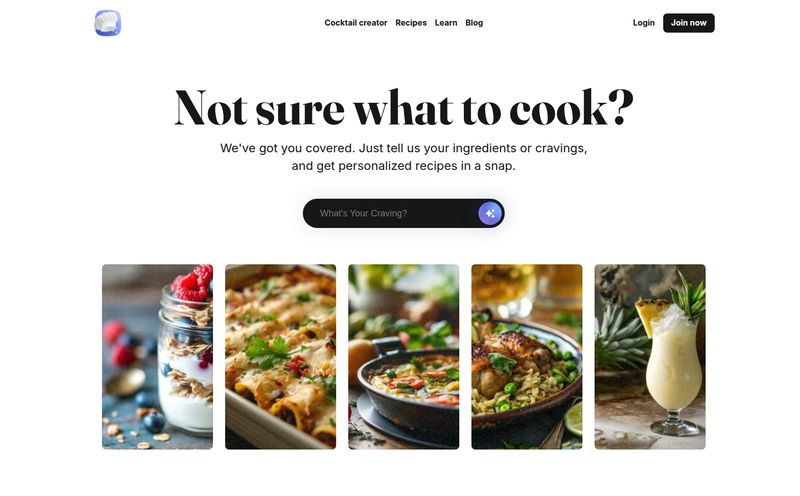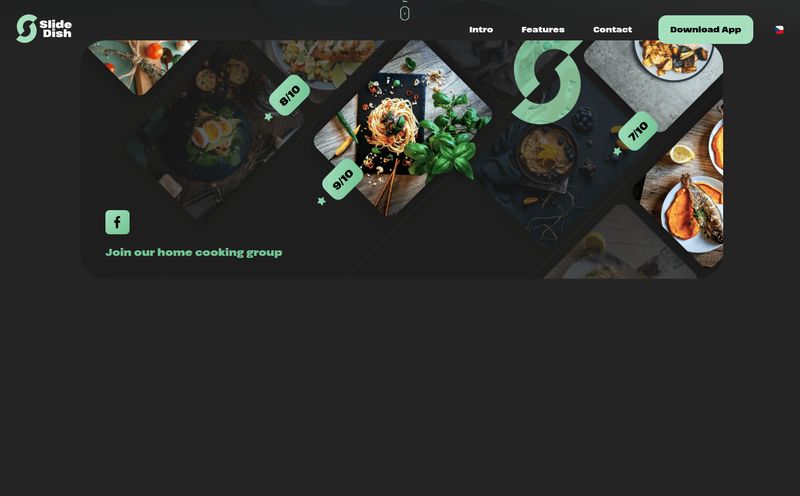We’ve all been there. It's 6 PM, you're staring into the abyss of your refrigerator, and the question hangs in the air, heavy with dread: “What’s for dinner?” You could scroll through the same five bookmarked food blogs. You could surrender and order takeout, again. Or you could do what we’ve all been doing lately—ask a chatbot.
I’ve thrown plenty of prompts at ChatGPT. “Give me a quick weeknight pasta recipe.” The results are… fine. Serviceable. But they often lack a certain soul, a bit of that chef's intuition that separates a decent meal from a memorable one. They feel like a mashup of the top 10 search results for “pasta recipe.”
So, when I stumbled upon Sage Cooking, my curiosity was definitely piqued. It’s not just another app. It claims to be a “next-generation recipe manager, powered by AI.” The promise isn't just to give you a recipe; it's to act as your personal, AI-powered sous chef, helping you turn your random cravings and leftover ingredients into something genuinely special. But does it actually deliver, or is it just more tech-fueled kitchen clutter? I had to find out.
What Exactly is Sage Cooking? (And What It's Not)
First off, let's clear the air. Sage Cooking isn’t just a fancy search engine. It’s a generative AI specifically trained on culinary knowledge. Think about the difference between a general practitioner and a heart surgeon. Both are smart, but you go to the surgeon for a specific, complex job. That's the idea here. Instead of a generalist AI that also knows how to code and write poetry, Sage is a specialist. Its world revolves around ingredients, techniques, flavor pairings, and timing.
The company behind it is playfully named “AI Dente, LLC,” which, as a word nerd, I have to appreciate. It signals a certain self-awareness and a love for the craft. This isn't just about code; it's about food.
The core concept is built on what they call “Collective Wisdom, Distilled.” Imagine a roundtable of seasoned chefs debating the best way to get a perfect sear on a scallop or balance the acidity in a vinaigrette. Sage aims to be the digital version of that conversation, giving you the consensus of expertise in a single, streamlined recipe. It's an ambitious goal, for sure.
The Promise of a Personal Chef on Your Countertop
The real magic seems to happen in the interaction. The homepage invites you to type in what you want to cook, offering examples like “spicy shrimp taco” or, my personal favorite, the beautifully vague “something fresh.” This is where it starts to feel different. It’s a conversation starter, not a search query.
From Vague Idea to Detailed Blueprint
We all have those moments. You feel like something citrusy, or maybe something comforting with cheese. Trying to translate that mood into a Google search is a nightmare. You end up wading through pages of listicles and food blogs with pop-ups galore.
Sage’s approach is to take that feeling, that initial spark of an idea, and build a complete culinary blueprint around it. It's designed to understand your intent. “Something fresh” won’t just give you a salad; it will likely ask more, or infer that you want bright flavors, maybe some herbs, and a lighter cooking method. It’s designed to cut through teh noise and get you straight to the cooking.
More Than Just Ingredients: The Culinary Intelligence
Here’s what really caught my eye. The platform boasts about its “Smart Recipe Intelligence” and being “Built with Layers of Culinary Know-How.” This is its main argument against just using a generic AI. It claims to understand technique. It knows that you bloom spices to deepen their flavor, that you rest meat to keep it juicy, and that the order of operations in a recipe isn't just a suggestion—it’s the foundation of the entire dish.
It’s like the difference between someone who can follow a recipe and a chef who can write one. A recipe might say, “sauté onions.” A chef knows you’re building a base layer of flavor, a soffritto or a mirepoix, that will define the entire dish. Sage is supposed to have that chef-level understanding. That’s a bold claim, and frankly, it's the one thing that could make this tool a true game-changer for home cooks.

Visit Sage Cooking
A Taste Test of AI-Generated Dishes
Looking at the gallery of “recently created” dishes on their site is like window shopping at a Michelin-starred restaurant. We’re talking “Poached Dory with Croute and Prosciutto Lemon Whipped Avocado” and “Niman Lamb Loin with Piment Artichokes, White Wine, and Herbs.” This is not your mom's tuna casserole. This is food designed to impress.
It immediately sparks ideas. What if I could finally figure out what to do with that weird bottle of pomegranate molasses in my pantry? I could just ask: “Give me a recipe for chicken thighs using pomegranate molasses and pistachios.” The potential for experimentation is huge. It transforms your pantry from a random collection of goods into a palette of possibilities.
This is where I see the biggest benefit for seasoned cooks, too—breaking out of a rut. We all have our go-to flavour profiles. Sage could be the creative partner that pushes you to try something new, pairing ingredients you’d never think to combine.
The Good, The Bad, and The AI-Seasoned
No tool is perfect, of course. As an SEO, I live in a world of algorithms, and I know they have their quirks. So, let’s talk about the potential pros and cons.
On one hand, the advantages are obvious. It's a massive time-saver and a powerful antidote to decision fatigue. The ability to customize for dietary needs on the fly—truly customize, not just filter—is incredible. Want that lamb dish to be paleo? Or that risotto to be vegan and gluten-free? An AI can theoretically reformulate it on a chemical and technical level, not just swap ingredients and hope for the best.
But there are things to be wary of. There's a risk of becoming too reliant on the tech, losing that hands-on, intuitive knowledge that comes from years of cooking, of making mistakes and learning from them. Some might argue it sanitizes the beautiful, messy process of learning to cook. I don’t fully buy that—I see it more as a powerful learning tool, like a flight simulator for pilots—but it's a valid point to consider.
And like any AI, the output quality depends on the input. You’ll have to learn how to “speak” its language to get the best results. There will probably be some trial and error, and maybe a few… interesting… meal suggestions before you get the hang of it.
So, How Much Does This Culinary Genius Cost?
This is the million-dollar question, isn't it? I clicked over to their pricing page, ready for the typical three-tiered subscription model. The page is titled “Simple Pricing for Every Home Cook.” And then… nothing. There’s no price listed. Not a single number.
My guess? Sage Cooking might be in an early-access phase or a public beta, gathering user feedback before they roll out a paid plan. Or maybe they're planning a freemium model, with a certain number of free recipes per month. For now, it seems to be free to try, which is fantastic. It lowers the barrier to entry to zero. You can just go play with it and see if it works for you without pulling out your credit card. I’d recommend jumping in while this is the case.
Who is Sage Cooking Really For?
After digging in, I think I have a good idea of the ideal user. This is for the adventurous home cook, the person who sees a new ingredient at the farmer's market and thinks, “I wonder what I can do with this?”
It’s for the busy professional who loves good food but is mentally drained after a long day of work and just wants a great recipe without the cognitive load of planning.
And it's a godsend for anyone with specific dietary needs. The ability to generate creative, exciting recipes that fit within strict parameters like keto, vegan, or allergy-friendly is a huge win.
Who isn't it for? Maybe the staunch traditionalist who cherishes their grandmother’s handwritten recipe cards. And that's okay. But for anyone looking to bring a little more creativity and a lot less stress into their kitchen, Sage Cooking feels like a glimpse into the future.
Conclusion: Your Next Sous Chef is an Algorithm?
I started this journey as a skeptic, and I'm walking away as a cautious optimist. Sage Cooking isn't just another recipe database. It's a creative partner. It’s a tool that respects the art and science of cooking while leveraging technology to make it more accessible and exciting. The promise of chef-level intelligence in your kitchen is intoxicating.
Will it replace the joy of flipping through a physical cookbook or the intuition you develop over time? No. But it can absolutely be a powerful new tool in your culinary arsenal. It might just be the thing that gets you to finally use that jar of preserved lemons. Go on, give it a prompt. Your next signature dish might be a collaboration with an AI. What a wild time to be alive.
Frequently Asked Questions about Sage Cooking
What is Sage Cooking?
Sage Cooking is an advanced recipe manager that uses artificial intelligence to generate and customize recipes. You can give it simple prompts, and it creates detailed, chef-inspired dishes tailored to your tastes, ingredients, and dietary needs.
How does the AI recipe generation work?
Unlike a search engine, Sage's AI is specifically trained on culinary data. It understands cooking techniques, flavor pairings, and recipe structures. When you provide a prompt, it generates a new, unique recipe based on these principles, much like a professional chef would.
Is Sage Cooking free to use?
Currently, the Sage Cooking website does not list any pricing information, which suggests it may be free to use during an initial beta or launch period. It's best to visit their site for the most current information.
Can I use Sage Cooking for my specific diet?
Yes, absolutely. One of the main strengths of Sage Cooking is its ability to customize recipes. You can ask it to generate meals that are vegan, paleo, gluten-free, low-carb, or tailored to specific allergies and dietary restrictions.
Is Sage Cooking better than using ChatGPT for recipes?
While ChatGPT can provide recipes, it is a general-purpose AI. Sage Cooking is a specialist, trained exclusively on food and cooking. This means it has a deeper understanding of culinary techniques and principles, theoretically leading to higher-quality, more reliable, and more creative recipes.
What kind of cook is Sage Cooking best for?
Sage Cooking is great for adventurous home cooks looking for inspiration, busy people who want to reduce meal-planning stress, and anyone with dietary restrictions seeking more variety in their meals.



